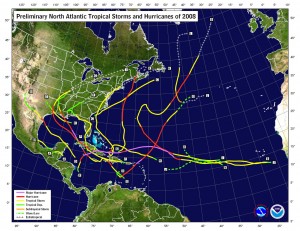
Sunday, November 30th marks the close of the hurricane season and the National Oceanic and Atmospheric Administration says it was one for the record books. The season marks one of the more active in the last 64 years overall and resulted in a record number of consecutive storms striking the United States.
According to Gerry Bell, Ph.D, the lead seasonal forecaster at NOAA, “This year’s hurricane season continues the current active hurricane era and is the tenth season to produce above-normal activity in the past 14 years.” It is important to note however that comprehensive record keeping of hurricanes has only been occurring for the last 64 years so there is not a great deal of data to draw upon.
In all, a total of 16 named storms formed this season, eight of which were hurricanes. Five of those were major hurricanes of category 3 strength or higher. An average hurricane season has 11 named storms, six hurricanes and two major hurricanes. In May at the start of the 2008 season, NOAA forecasters predicted 12 to 16 named storms and then in August upped their predictions to 14 to 18 named storms. This represents the first time in recent years forecasters had accurately bracketed the number of storms. In 2007 NOAA predicted 10 hurricanes and only six formed. The year prior, 2006, nine hurricanes were forecasted by NOAA but only five formed. In 2005, the year Hurricane Katrina devastated New Orleans in the worst U.S. natural disaster, the forecasts underestimated storm activity.
2008 ties as the fourth most active season in terms of named storms (16) and major hurricanes (5). It also tied as fifth most active in terms of hurricanes overall (8) since 1944.
From NOAA, most notably:
For the first time on record, six consecutive tropical cyclones (Dolly, Edouard, Fay, Gustav, Hanna and Ike) made landfall on the U.S. mainland and a record three major hurricanes (Gustav, Ike and Paloma) struck Cuba. This is also the first Atlantic season to have a major hurricane (Category 3) form in five consecutive months (July: Bertha, August: Gustav, September: Ike, October: Omar, November: Paloma).
Bell attributes the active season to ongoing increased activity since 1995, lingering La Nina effects and warmer tropical Atlantic Ocean effects.
Here is a fascinating video from NOAA using satellite imagery of the entire hurricane season:
